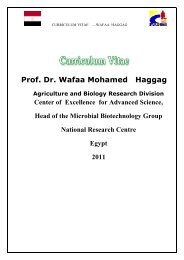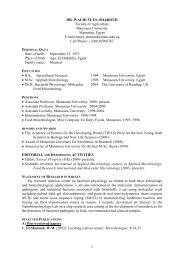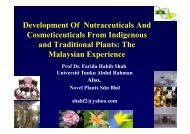Dr. Hany Gado, Professor of Animal Nutrition Faculty Of Agriculture ...
Dr. Hany Gado, Professor of Animal Nutrition Faculty Of Agriculture ...
Dr. Hany Gado, Professor of Animal Nutrition Faculty Of Agriculture ...
You also want an ePaper? Increase the reach of your titles
YUMPU automatically turns print PDFs into web optimized ePapers that Google loves.
The Use <strong>Of</strong> Anaerobic Enzymes And Bacteria<br />
In <strong>Animal</strong> Feed Industry<br />
<strong>Dr</strong>. <strong>Hany</strong> <strong>Gado</strong>,<br />
<strong>Pr<strong>of</strong>essor</strong> <strong>of</strong> <strong>Animal</strong> <strong>Nutrition</strong><br />
<strong>Faculty</strong> <strong>Of</strong> <strong>Agriculture</strong>,<br />
Ain Shams University, y, Egypt. gyp
INTRODUCTION
Exogenous enzymes have been used<br />
extensively :<br />
- to remove anti-nutritional factors<br />
from feeds,<br />
- to increase the digestibility <strong>of</strong><br />
existing nutrients,<br />
and to supplement the activity <strong>of</strong> the<br />
- and to supplement the activity <strong>of</strong> the<br />
endogenous enzymes <strong>of</strong> poultry
Researchers in the 1960s examined<br />
the use <strong>of</strong> exogenous enzymes but<br />
responses were variable and no effort<br />
was made to determine the mode <strong>of</strong><br />
action <strong>of</strong> these products.<br />
p
Furthermore Furthermore, production <strong>of</strong> exogenous<br />
enzymes was expensive at the time<br />
and it was not economically feasible to<br />
apply these preparations at the<br />
concentrations necessary y to elicit a<br />
positive animal response
. Recent reductions in fermentation<br />
costs, together with more active and<br />
better defined enzyme preparations,<br />
have prompted researchers to reexamine<br />
the role <strong>of</strong> exogenous g<br />
enzymes in ruminant production .
Several studies have attempted to<br />
define possible modes <strong>of</strong> action <strong>of</strong><br />
these additives. Exogenous enzymes<br />
could exert a number <strong>of</strong> effects, both<br />
on the gastrointestinal g<br />
micr<strong>of</strong>lora and<br />
on the ruminant animal itself. It is<br />
highly probable, therefore, that<br />
physiological responses to exogenous<br />
enzymes are multi-factorial in origin.
AAnaerobic bi enzymes<br />
They are enzymes produced by anaerobic<br />
bacteria. Their homology are almost similar<br />
to those produced inside the reticulo<br />
rumen complex.<br />
Most <strong>of</strong> the enzymes are in the markets are<br />
produced from fungus. It was proven that<br />
are in the back seat if they y are compared p<br />
to those produced from their natural<br />
habitat to act in their normal pathways.
Material And Methods
the tested roughages :<br />
rice straw, RS;<br />
corn stalks, t lk CS and d<br />
sugarcane bagasse,
ZAD (patent on: 22155) is biotechnical<br />
product made from natural sources to<br />
elevated level <strong>of</strong> cellulase enzyme<br />
from anaerobic bacteria which convert<br />
the polysaccharide p y<br />
into<br />
monosaccharide by specific enzymes<br />
(cellulase, 8.2 u/gm; hemi-cellulase,<br />
6.2 u/gm; amylase, 64.4 u/g and<br />
protease, 12.3 u/gm).
The experimental treatments were :<br />
3 liters <strong>of</strong> ZAD compound<br />
added dd d t to 1000 litt litter water t<br />
+ 50 kg molasses and<br />
20 kg urea for 1 ton <strong>of</strong> the feedstuff.
The two stage technique <strong>of</strong> Tilley and<br />
Terry (1963) as modified by Marten<br />
and Barnes (1979) was used to study<br />
the effect <strong>of</strong> the biological treatment<br />
<strong>of</strong> the tested roughages g g on in vitro dry y<br />
matter (IVDMD)
Rumen Liquor was obtained from two<br />
fistulated rams kept on high quality<br />
hay. The fluid was strained through 4<br />
layers <strong>of</strong> cheese cloth. The McDougal<br />
buffer (shown ( in the following g table) )<br />
was prepared, then urea was added at<br />
the rate <strong>of</strong> one g/L <strong>of</strong> buffer and mixed<br />
with rumen liquor at the ratio <strong>of</strong> (2<br />
buffer: 1 rumen liquor).
This mixture was saturated with CO CO2 and warmed at 39°C in a water bath. A<br />
volume <strong>of</strong> 250 ml <strong>of</strong> the mixture was<br />
added to each polyethylene tube<br />
containing g 0.5g g air dried sample p ( (in<br />
triplicate), then saturated with CO2 and tightly closed with rubber stopper<br />
fitted with outlet valve and incubated<br />
at 39°C in a water bath for 48 hours.
Tubes were well shaken twice daily<br />
during incubation period. At the end <strong>of</strong><br />
the incubation period, 6 ml <strong>of</strong> HCl<br />
(20%) was added gradually to each<br />
tube followed by y 2 ml <strong>of</strong> 5% pepsin. p p<br />
Tubes were closed and incubated in<br />
the water bath at 39°C for another 24<br />
hours.
Samples were filtered using a dry<br />
weighed Whatman filter paper (No.<br />
54) and the residue was washed with<br />
boiled water; the filter paper and<br />
residue was dried at 100°C overnight g<br />
and weighed after cooling in a<br />
desiccator
The IVDMD was calculated using the<br />
following equation:<br />
<br />
Where wt <strong>of</strong> substrate DM = dry tube<br />
plus l sample l – d dry ttube; b wt t <strong>of</strong> f residual id l<br />
DM = dry tube plus residue – dry tube.
Di Digestibility ibili trials: i l<br />
Two 3 x 3 Latin square designs were<br />
applied in this part <strong>of</strong> the study in<br />
order to determine the in vivo<br />
digestibility. Three Ossimi rams (with<br />
average g live body y wheat <strong>of</strong> 45 kg) g)<br />
were used in each design. Sheep were<br />
housed in individual metabolic crate.
Feed was <strong>of</strong>fered twice daily at 8:00<br />
and 14.00 hr. Fresh water was<br />
available at all times. Samples <strong>of</strong> feed<br />
were taken daily at 8:00 hr in the<br />
morning g and kept p in gglass<br />
bottle at the<br />
laboratory for later analysis. Feces and<br />
urine were quantitatively collected<br />
daily.
Weight <strong>of</strong> total feces and volume <strong>of</strong><br />
urine were recorded daily in the<br />
morning. The representative sample<br />
(10%) were taken from each animal<br />
during g the collection p period; ; each<br />
sample was sprayed with a solution <strong>of</strong><br />
10% formaldehyde in addition to 10%<br />
H2SO4 solution then the sample were<br />
dried in the forced air oven at 60-65 °C<br />
until il constant weight i h was reached.<br />
h d
The dried fecal samples for each<br />
animal were mixed and kept for<br />
labortory analysis. Urine samples were<br />
also collected daily for each animal in<br />
glass g botteles contained fifty y ml<br />
diluted sulfuric acid (10%) to avoid<br />
ammonia losses. Digestibility <strong>of</strong> all<br />
nutrients (CP, CF, EE and NFE were<br />
determined for each animal.
In order to determine the rumen<br />
fermentation characters (pH, VFA and<br />
NH NH3-N), 3 N), samples <strong>of</strong> rumen fluid were<br />
obtained at 0, 2, 4 and 6 hr after<br />
feeding. g The rumen samples p were<br />
collected through the cannula.The fluid<br />
was strained through 4 layers <strong>of</strong><br />
cheese cloth and pH was immediately<br />
determination.
Then a preservative was added to keep<br />
ammonia nitrogen unchanged. The<br />
liquor was stored in deep freezer at (<br />
20 C) until chemically analyzed using<br />
dried glass g bottles with adding g 0.5 ml<br />
toluene and 1 ml paraffin oil to each<br />
sample.
PProximate i analysis: l i<br />
Samples <strong>of</strong> the untreated and treated<br />
roughages were ground and subjected<br />
in duplicate to proximate analysis.<br />
Samples <strong>of</strong> daily output <strong>of</strong> feces were<br />
taken after drying y g at 60 °C for 24 hr<br />
and then they were also ground. All<br />
the ground samples were stored in<br />
stoppered bottles.
<strong>Dr</strong>y matter (DM), (DM) crude protein (CP), (CP)<br />
and crude fiber (CF) and ash <strong>of</strong> the<br />
feedstuffs and feces samples were<br />
determined according to A.O.A.C.<br />
(1990). ( ) The nitrogen g free extract<br />
(NFE) was calculated by difference.
Representative samples <strong>of</strong> the tested<br />
roughages, experimental rations and<br />
feces were analyzed for fiber fraction<br />
according to Van Soest and Breston<br />
(1979) ( ) to determine neutral detergent g<br />
fiber (NDF), acid detergent fiber (ADF)<br />
and acid detergent lignin (ADL).<br />
Cellulose and hemi-cellulose were<br />
determined by difference.
ZADO<br />
It is a powder product (patent) contains<br />
group <strong>of</strong> enzymes from anaerobic sources.<br />
It could be added during the peltzing<br />
operation. It can handle heat and pressure<br />
<strong>of</strong> the manufacturing process process.<br />
It could be added as 5 kg/ton <strong>of</strong> feed<br />
It could be <strong>of</strong>fered as 40 gm/head/day for<br />
cattle ,w.buffalo and camels.<br />
It is <strong>of</strong>fered as 10 gm/head/day for sheep
RESULTS AND DISCUSSION
Effect <strong>of</strong> ZAD on chemical composition <strong>of</strong><br />
Bagasse Bagasse, Rice straw and Corn stalks<br />
item Bagasse Rice straw Corn stalks<br />
with ith with ith with ith<br />
control ZAD control ZAD control ZAD<br />
b 83.4a DM 90.1<br />
91.3<br />
b 83.4 91.3<br />
90.1 89.3 85.98<br />
OM 95.4e 84.4a 87.70 85.4 92.6e 79.1a OM 95.4 84.4 87.70 85.4 92.6<br />
CP 1.9 a 11.2 e 3.50 a 12.50 d<br />
4.3 a 14.1 e<br />
EE 1.40 a 4.0 d 1.2 2.4 2.4 a 3.6 b<br />
36.5 d b b 44.6c NFE 46.3d 39.1ab 40.4e 36.5 44.6<br />
37.2 a<br />
CF 48 3f 30 6a 38 3c 36.7a 36 8e 25 2a CF 48.3 30.6 38.3 36.8 25.2<br />
a and b Means with different superscripts on the same column are different at (P
Effect <strong>of</strong> ZAD on fiber fraction <strong>of</strong> Bagasse Bagasse, Rice straw<br />
and Corn stalks<br />
item Bagasse Rice straw Corn stalks<br />
with<br />
with<br />
with<br />
control ZAD control ZAD control ZAD<br />
NDF 70.92 b 59.5 a 63.67 b 52.3 a 61.5 b 52.4 a<br />
ADF 50.97 b 40.4 a 43.7 b 32.2 a 42.1 b 31.5 a<br />
ADL 12.01 11.3 11.2 9.86 10.1 9.7<br />
a and b Means with different superscripts on the same column are different at (P
Table ( 2 ): Effect <strong>of</strong> biological treatment on IVDMD<br />
HOURS Baggasse Rice straw Corn stalks<br />
with<br />
with<br />
with<br />
control ZAD control ZAD control ZAD<br />
2 7.9b11.5a 9.6b 14.6a 8.3b 15.2a 4 16.8 17.7 14.3 18.1 18.7b 24.1a 6 29 6b 43 7a 31 8 36 8 34 0b 40 3a 6 29.6b 43.7a 31.8 36.8 34.0b 40.3a 24 37.4b 59.8a 44.0 44.3 55.3b 64.1a 48 69.4b 83.4a 57.3b 68.6a 69.7b 82.5a 8 69 83 5 3 68 6 69 8 5<br />
a and b Means with different superscripts on the same column are different at (P
Table ( 3 ) Effect <strong>of</strong> biological treatment on<br />
digestion coefficient in sheep<br />
Item Baggasse gg<br />
Rice straw Corn stalks<br />
with<br />
with<br />
with<br />
control ZAD control ZAD control ZAD<br />
DM,% 70.2b 86a 69.4b 82.6a 59.4b 72a OM,% 79.5b 83.6a 73.8b 87.7a 63.5b 82.6a CP,% 62.3b 69.6a 35.4b 61.8a 54.3b 77.3a CF,% 60.4b 76.5a 55.2b 87.8a 60.3b 79.4a EE,% 82.6b 76.9a 62.4b 88.1a 90 84<br />
NFE,% 83.3 82.2 75.2b 87.6a 70.3 70.8<br />
NDF,% 60.1b 72.8a 69.2b 79.1a 67.3b 86.1a ADF,% 73.1b 81.6a 71.2b 88.4a 60.3b 88.2b TDN,% 51.3b 72.2a 54.9b 70a 48.8b 70.2a a and b Means with different superscripts on the same column are different at (P
Table (4) : Effect <strong>of</strong> biological treatment on rumen<br />
TVA"s (M.EQU./100 ML) in sheep<br />
Hours Baggasse Rice straw Corn stalks<br />
with with with<br />
control ZAD Control ZAD control ZAD<br />
0 99.1 1 10 10.66 9 10 9 10 10.88<br />
2 10 8b 13 9a 10 8b 12 6a 10b 12 1a 2 10.8 13.9 10.8 12.6 10 12.1<br />
4 13.2 12.9 12 b 16 a 11.1 b 14.2 a<br />
6 11.1 b 13.4 a 10 11.5 9.9 b 13.4 a<br />
a and b Means with different superscripts on the same column are different at (P
Feeding Enzyme Powder to<br />
RRuminants i t
DAIRY
Milk production and composition for cows fed diets<br />
containing t i i enzyme treatments t t t applied li d to t different diff t<br />
components <strong>of</strong> a TMR.<br />
Treatments<br />
Item<br />
Milk production, kg/d<br />
CTRL with ZADO SE<br />
A t l 14 0b Actual 14.0 15 6 0 4<br />
b 15.6a 0.4<br />
4% FCM 12.9b 15.5a 1.2<br />
3.5% FCM 14.0b 16.8a Energy Corrected<br />
Milk,KG 13.9b 17.1a Milk composition, %<br />
Fat 3.8a 3.9 0.1<br />
PProtein t i 33.5 5 33.6 6 00.1 1<br />
Lactose 4.5 4.5 0.05<br />
Milk composition, kg/d<br />
Fat 0.55 0.62 0.06<br />
Protein 0.49 0.56 0.02<br />
Lactose 0.63 0.71 0.04<br />
Milk/kg DMI 00.85 85 00.89 89 00.04 04<br />
a and b Means with different superscripts on the same column are different at (P
ZADO and dairy breed<br />
item Fresian Brown Swiss<br />
con trol zado control zado<br />
No. <strong>of</strong> animals 147 147 54 54<br />
Milk production/d/head 30.1 32.1 12.2 14.4<br />
Effect <strong>of</strong> ZADO 6.30% 7%<br />
fat % 3.5 3.8 3.7% 4.2%<br />
mastitis cases 2 0 0 0<br />
net margin for treatment,egy 0 2.18 0 2.98<br />
ration content<br />
DMI, KG 19.7 19.7 16.9 16.9<br />
TDN,% 76 76 77 77<br />
CP,% 16.5 16.5 16.8 16.8<br />
ADF,% 20 20 19 19<br />
Nel (Mcal/kg DM) 1.7 1.7 1.68 1.68<br />
a and b Means with different superscripts on the same column are different at (P
SHEEP
Effect <strong>of</strong> ZADO on SHEEP performance<br />
Control + ZADO ® SEM<br />
No. <strong>of</strong> lambs 50 50 ---<br />
Experimental period 90 90<br />
Initial live-weight, kg 18.3 18.5 0.25<br />
Final live weight kg 32 8c 38 9a Final live-weight, kg 32.8 5 05<br />
c 38.9a 5.05<br />
Live-weight gain, kg/d 0.24c 0.34a 0.062<br />
DMI,kg/head/day 1.23 1.72<br />
Net pr<strong>of</strong>it, US $/head/day 0.97 1.38<br />
Cost in US $ <strong>of</strong><br />
ZADO/head/day<br />
0 0.002<br />
Feed efficiency, kg<br />
DM/kg live weight gain<br />
5.1 5.06 0.07<br />
a and b Means with different superscripts on the same column are different at (P
FATTENING CATTLE AND<br />
W.BUFFALO
1st 1st period period<br />
Effe Effect t <strong>of</strong> ZADO on cattle attle and w.buffalo b ffalo pe performance fo man e<br />
CATTLE W.BUFFALO<br />
Item control<br />
plus l<br />
ZADO control plus ZADO SEM<br />
feeding days 91 81 83 78 3.55<br />
no. <strong>of</strong> animals 54 50 60 62 4.78<br />
initial wt.,kg 152 155 153 149 10.2<br />
final wt. 251 255 248 249 2.5<br />
DMI,kg/d 5 5.1 5 5 0.26<br />
ADG, kg/d 1.1b 1.24a 1.15b 1.28a Kilograms <strong>of</strong>feed<br />
DM:Kilograms<br />
0.34<br />
<strong>of</strong> gain g<br />
4.55 4.11 4.35 3.91 1.25<br />
a and b Means with different superscripts on the same column are different at (P
Item<br />
2nd period<br />
continued i d<br />
CATTLE WW.BUFFALO BUFFALO<br />
control plus ZADO control<br />
plus<br />
ZADO<br />
feeding days 102.4 92.0 109.1 94.2<br />
no. <strong>of</strong> animals 54 50 60 62 0.12<br />
initial wt.,kg 250 255 248 250 4.6<br />
fi final l wt. t 375 382 379 381 88.4 4<br />
DMI,kg/d 7.81 7.96 7.84 7.9 6.9<br />
ADG kg/d 1 22b 1 38a 1 2b 1 39a ADG, kg/d 1.22 0 35<br />
b 1.38a 1.2b 1.39a Kilograms <strong>of</strong><br />
feed<br />
DM:Kilogram<br />
0.35<br />
s <strong>of</strong> gain 6.40 5.7 6.5 5.6 8.9<br />
a and b Means with different superscripts on the same column are different at (P
3rd 3rd period period<br />
Cattle Water buffalo<br />
plus<br />
plus<br />
Item control ZADO control ZADO ±SE<br />
Feeding days 56.8 48.6 56.0 52.1<br />
no. <strong>of</strong> f animals i l 54 50 60 62 00.12 12<br />
initial wt.,kg 375 382 379 381 8.4<br />
fi final l wt. t 446 452 448 454 99.1 1<br />
DMI,kg/d 10.2 10.4 10.4 10.4 5.8<br />
1 25b 1 44a 1 23b 1 4a ADG, kg/d 1.25 0 47<br />
b 1.44a 1.23b 1.4a 0.47<br />
Kilograms <strong>of</strong> feed<br />
DM:Kilograms <strong>of</strong> gain 8.16 7.2 8.4 7.4 9.4<br />
g g<br />
a and b Means with different superscripts on the same column are different at (P
CATTLE WW.BUFFALO BUFFALO<br />
plus p<br />
plus p<br />
Item control ZADO control ZADO ±SE<br />
The overall calculations<br />
Feeding g days y 250.2 221.6 248.2 224.3 12.6<br />
1 19b 1 3a 1 1b 1 3a ADG, kg/d 1.19 0 3<br />
b 1.3a 1.1b 1.3a 0.3<br />
Kilograms <strong>of</strong><br />
feed<br />
DM:Kilogram<br />
s<strong>of</strong> gain 6.3 5.7 6.4 5.6 7.5<br />
g<br />
a and b Means with different superscripts on the same column are different at (P
SUMMARY
Using ZAD to treat rice straw , bagasse and<br />
corn stalks during the ensiling period <strong>of</strong> 4<br />
weeks resulted the following:<br />
1. decreased the CF for the experimental<br />
products in a range from 30 30.3 3 to 36 36.6% 6%<br />
2. An improvement in the CP wss recorded<br />
more with 80% from microbial protein<br />
orgin
33.ZAD ZAD decreased NDF rice straw , bagasse<br />
and corn stalks in range from 30.3 to<br />
36.6%<br />
4. The same trend went through for ADF in<br />
range <strong>of</strong> 20 20.6 6 to 26 26.3 3 %<br />
5. INVDMD extent improved in the treat<br />
fibrous materials to reach the 80% level in<br />
comparison to the control group which<br />
didn’t didn t exceed the 60’s 60 s in percentage wise.
In Vivo results showed an increase in the<br />
digestibility for DM, OM, CP,EE, CF, NDF<br />
AND ADF which reflected on the TDN value<br />
to reach the 70’s in animals fed ZAD<br />
treated tested by-products y p in comparison p<br />
to animals fed untreated rice straw or<br />
bagasse or corn stalks ( 50’s %)
Total volatile fatty acids in animals fed ZAD<br />
treat rice straw or treated bagasse or<br />
treated corn stalks went up with the time<br />
progress after feeding. That is showing an<br />
increase in the microbial digestion g<br />
efficiency Also, that will be reflected on<br />
available energy through the metabolism<br />
system <strong>of</strong> the animal.
Feeding ZADO improved milk production by<br />
1.5 / head/day all the milking season<br />
It increased the meat production by 150<br />
gm /hea/day for cattle and w.buffalo.<br />
Sheep produced 100 gm head per day as<br />
Sheep produced 100 gm head per day as<br />
result <strong>of</strong> feeding zado powder.
Th Thanks k اك اركش
















